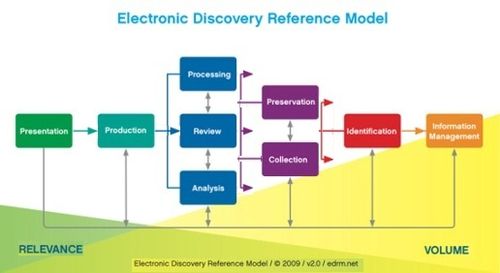Brad Jenkins of CloudNine Discovery – eDiscovery Trends

This is the first of the 2014 LegalTech New York (LTNY) Thought Leader Interview series. eDiscoveryDaily interviewed several thought leaders after LTNY this year (don’t get us started) and generally asked each of them the following questions:
- What significant eDiscovery trends do you see for 2014?
- With new amendments to discovery provisions of the Federal Rules of Civil Procedure now in the comment phase, do you see those being approved this year and what do you see as the impact of those Rules changes?
- It seems despite numerous resources in the industry, most attorneys still don’t know a lot about eDiscovery? Do you agree with that and, if so, what do you think can be done to improve the situation?
- What are you working on that you’d like our readers to know about?
Today’s thought leader is Brad Jenkins of CloudNine Discovery. Brad has over 20 years of experience as an entrepreneur, as well as 15 years leading customer focused companies in the litigation support arena. Brad also writes the Litigation Support Industry Blog, which covers news about litigation support and eDiscovery companies’ funding activities, acquisitions & mergers and notable business successes. He has authored several articles on document management and litigation support issues, and has appeared as a speaker before national audiences on document management practices and solutions. He’s also my boss!
What significant eDiscovery trends do you see for 2014?
Well, I think that technology assisted review tools will continue to gain traction and the software will continue to make the review process more intuitive. I think predictive coding software is evolving to provide real-time predicted relevance scores for the collection as each document is reviewed. One of our partners, Hot Neuron, announced last month that Version 4.0 of their Clustify software, is the first technology-assisted review tool to offer real-time predictive coding. I also think that the technology associated with predictive coding will be used more in other areas of the eDiscovery life cycle, particularly Information Governance.
Another trend, one that I discussed last year, is integration of “best of breed” cloud-based applications to make the discovery process more seamless. Our alliance with BIA and the integration of their TotalDiscovery legal hold and collection tool to our review application, OnDemand®, has continued to be used by our clients to support preservation through production. BIA has tremendous expertise and software to support the left side of the EDRM model and it’s a logical fit for the services and software we provide from collection to production. Personally, I believe that the “best of breed” integrated applications approach is a preferable alternative to a complete solution because it’s difficult to be an expert in all phases of discovery.
I also think that it’s more difficult than ever for the small to medium sized firm to compete with the big firm that has most of the attention from the eDiscovery vendor market and has more resources in house to manage their discovery workload. Most small to mid-sized firms lack the core competency, the infrastructure, the project management expertise and the overall personnel in house to provide the full range of services that large corporate clients are demanding, especially for litigation support and discovery services. More than ever, these firms will need to leverage virtual resources to compete and provide the level of services their clients expect.
With new amendments to discovery provisions of the Federal Rules of Civil Procedure now in the comment phase, do you see those being approved this year and what do you see as the impact of those Rules changes?
I don’t really have a prediction as to whether they will be approved this year. I know there has been controversy with some of the proposed rules changes, especially Rule 37(e), regarding the level of culpability required to justify severe sanctions for spoliation and that Judge Scheindlin and others have criticized the rule. I wouldn’t be surprised to see some changes to that rule before adoption. Regardless, it seems like a lot of attorneys don’t follow the rules adopted back in 2006, so the rules will only be effective if attorneys adhere to those rules and courts hold them to those standards.
It seems despite numerous resources in the industry, most attorneys still don’t know a lot about eDiscovery? Do you agree with that and, if so, what do you think can be done to improve the situation?
Yes, I agree. We work with a lot of firms whose attorneys lack basic eDiscovery fundamentals. In some cases, the managing partners know that and have been asking for us to provide seminars and webinars to educate them on eDiscovery best practices. And, we have been providing more consulting than ever to attorneys to assist them with technical language in requests for production to ensure that they receive the most useful form of production such as native files with included metadata.
As for what can be done, I think it’s imperative for each provider to provide resources to educate their clients and the legal profession as a whole. We do that with our blog, eDiscoveryDaily. As we approach 300,000 lifetime hits and 1,000 lifetime posts, both of which we will reach later this year, I’m proud of the knowledge base that this blog has become. This year, we are also looking to really ramp up CLE training for attorneys that want to become more comfortable with technology. There are numerous other great blogs and resources out there too. I think we have to keep pushing and keep finding ways to reach attorneys and give them useful resources that can simplify the discovery process, which is what we’re all about at CloudNine.
What are you working on that you’d like our readers to know about?
In addition to our continued integration success with BIA and our partnership with Clustify, we recently released a brand new version of our review application OnDemand® , called Universal OnDemand. We called it “Universal” because we have re-designed it to work in any browser, so clients can use it whether they prefer Internet Explorer, Firefox, Google Chrome or even Safari on a Mac. We will be working to expand the application to support use with tablets this year and, as always, working to add features requested by our clients, who are the primary drivers of our development priorities.
We have also been working on a new advanced program that we call the Virtual BIG Firm™ program. It’s a unique package of the full range of services that we have provided for years, along with our OnDemand review platform, for mid-sized firms that want to compete with the big firms, but don’t have the personnel, infrastructure or expertise to make it happen. We created our Virtual BIG Firm program based on our experience working with over one hundred law firms for more than eleven years. Our Virtual BIG Firm program appeals to firms interested in growing their practice. These firms value continuing legal education, technology advances and they feel comfortable delegating. It’s not for everybody, so we continue to offer our basic services and software as we always have, but for the firm that has a significant litigation workload but not the resources to fully manage it effectively, it’s a program that provides those resources at a fraction of what big firms spend on personnel & technology.
Thanks, Brad, for participating in the interview!
And to the readers, as always, please share any comments you might have or if you’d like to know more about a particular topic!
Disclaimer: The views represented herein are exclusively the views of the author, and do not necessarily represent the views held by CloudNine Discovery. eDiscoveryDaily is made available by CloudNine Discovery solely for educational purposes to provide general information about general eDiscovery principles and not to provide specific legal advice applicable to any particular circumstance. eDiscoveryDaily should not be used as a substitute for competent legal advice from a lawyer you have retained and who has agreed to represent you.







